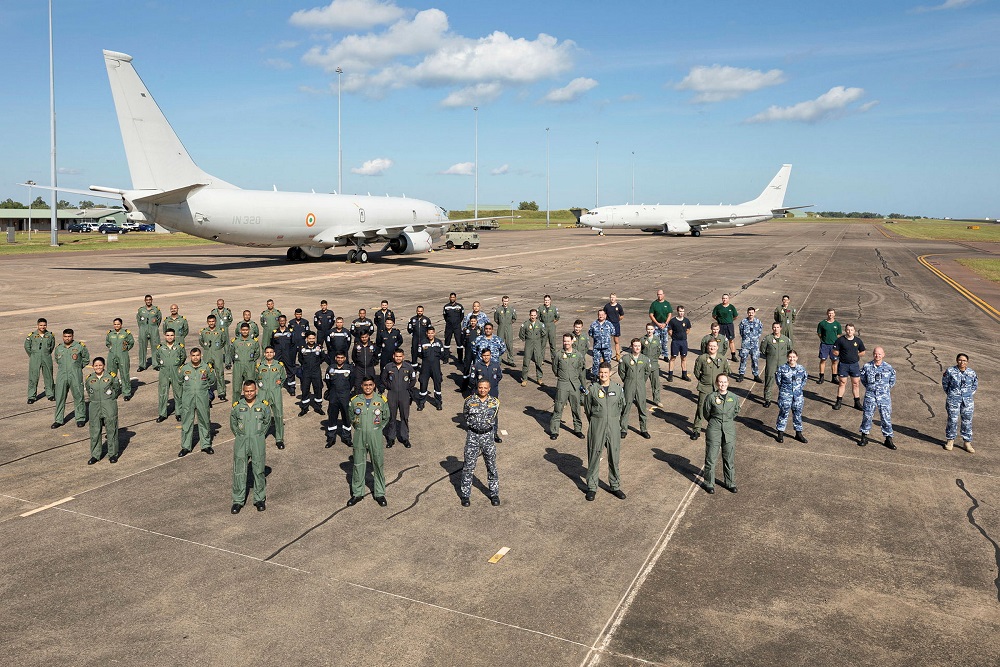
Despite Australia’s hopes, the Indian military will not be participating in the Australian Defence Force’s multinational Exercise Talisman Sabre later this month. But that shouldn’t be taken as a reflection of the Australia–India defence relationship. This week several aircraft from India’s navy and air force made a groundbreaking visit to Australia’s Cocos (Keeling) Islands. The visit represents an important step in the bilateral relationship as the two countries increasingly give each other access to their military facilities in the Indian Ocean.
Since 2022, Australian and Indian naval aircraft have been regularly hosted at each other’s facilities, making use of a mutual logistics support arrangement signed in 2020. This has included visits by Indian P-8I maritime patrol aircraft to Darwin and visits by Australian P-8A aircraft to Goa and (earlier this week) to Tamil Nadu in southern India. The use of each other’s facilities allows Australian and Indian aircraft to undertake coordinated operations right across the northern Indian Ocean, from the Arabian Sea to the Bay of Bengal and Southeast Asia.
Analysts have also long been calling for Indian access to the Cocos Islands airfield, which is being strengthened and expanded to take P-8 maritime patrol aircraft. Indeed, since 2021 the territory has been used to support Indian space missions.
This week’s visit by Indian Navy Dornier maritime patrol aircraft and a C-130 Hercules from the Indian Air Force effectively elevates the Cocos Islands as a staging point for Australian and Indian air surveillance of the maritime choke points through Southeast Asia and the entire eastern Indian Ocean.
For Australia, the visit should be seen as part of its efforts to develop a network of maritime security partnerships in the eastern Indian Ocean. For more than a decade, Australia has focused on strengthening its bilateral defence relationship with India, but its Indian Ocean focus is fast expanding to include other partners in the region, such as Sri Lanka, Bangladesh and Maldives. This is an important step in building an Indian Ocean coalition that, while consistent with US interests, doesn’t necessarily rely on US capacity or capability.
The Indian Ocean is too big for any one country to monitor. To achieve an acceptable level of maritime domain awareness, Australia needs to build partnerships with key countries such as India and France, as well as others in the region. This will require a web of relationships among partners that can, in different ways, contribute maritime surveillance capabilities and necessary facilities.
Sri Lanka has long been seen as an important regional partner, although much of the focus over the past decade has been on combating people smuggling. Australia–Sri Lanka defence ties are in the process of being expanded with a broader focus on maritime security.
In 2019, as part of Indo-Pacific Endeavour, a Royal Australian Air Force P-8A patrol aircraft made a symbolically important visit to Hambantota in southern Sri Lanka, where a Chinese company controversially controls the nearby port. In May this year, Australia donated a Beechcraft KA350 twin-engine turboprop aircraft to the Sri Lankan Air Force to complement the 2014 gift of two Bay-class offshore patrol vessels to the Sri Lankan Navy. Further gifts should be expected. A broad-based security partnership with Sri Lanka will provide Australia with many new options in developing its presence in the Bay of Bengal.
Maldives is also a new regional security partner. In a major step, a RAAF P-8A patrol aircraft quietly visited Gan in southern Maldives in October 2022. Gan was a big British air and naval base until the mid-1970s and boasts an extended runway of 3,400 metres. Gan’s location in the central Indian Ocean, some 700 kilometres north of the joint US–UK base at Diego Garcia, makes it prime real estate—especially given the growing uncertainties about the future of that base.
As part of Indo-Pacific Endeavour 2023, RAAF aircraft will visit Maldives, Sri Lanka and Bangladesh. Those visits could potentially be expanded in 2024 to include Australian naval visits.
Regular visits by Australian ships and aircraft to India and other partners in the northeast Indian Ocean will be important in familiarising ADF personnel with those nations and their facilities, as well as further developing Australia’s maritime and surveillance presence in the eastern Indian Ocean.
Australia is also stepping up its assistance to Bangladesh, Sri Lanka and Maldives in building their maritime domain awareness capabilities. It is very much in Australia’s interests to ensure that its neighbours have strong, sovereign capabilities to properly govern their maritime zones against a range of threats, such as illegal fishing, drug smuggling and human trafficking.
Both Australia and India remain focused on developing their defence partnership in new areas, including working with each other to build maritime domain awareness in the Indian Ocean. This task will require working with partners around the region to govern shared maritime spaces.
This article was written as part of the Australia India Institute’s defence program undertaken with the support of the Australian Department of Defence. All views expressed in this article are those of the authors only.

